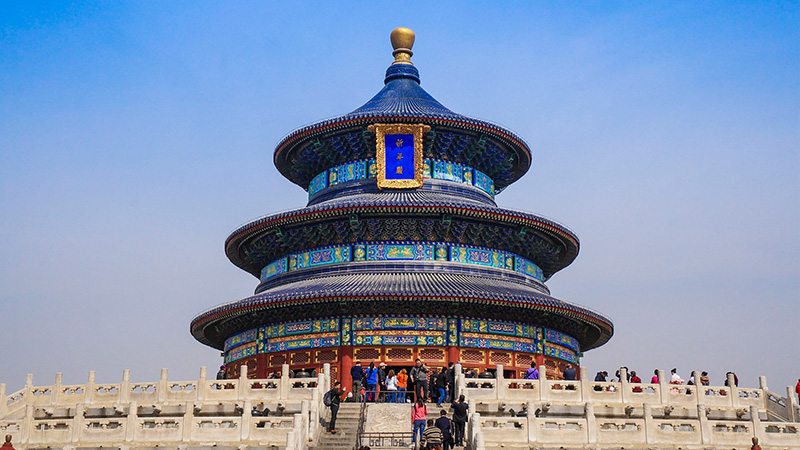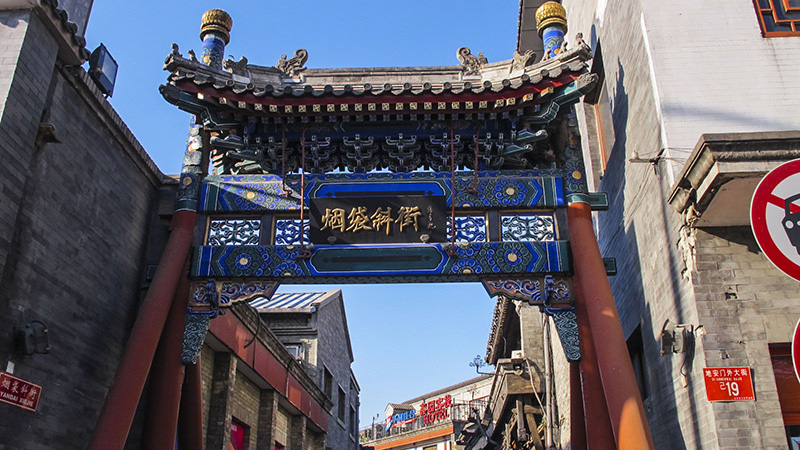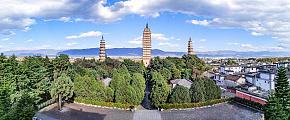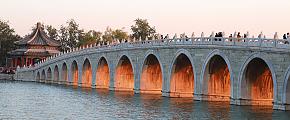Chinese Architectures - Altar, Archway, Marble Boat , Scenic Opening
One of the unique parts of Chinese architecture is the altar. If you do a Beijing tour, you will see many altars. The Chinese tan is an altar where ancient rulers used to offer sacrifices to Heaven or the gods, and architecturally it refers to a special type of terrace-like building. Several ancient tans in Beijing, mostly dating from the Ming (1368-1644) and Qing (1644-1911) dynasties, have remained in name if not in fact. A number of Beijing's parks, for instance, still have the word tan in their names:
Tiantan (Temple of Heaven), Yuetan (Altar to the Moon), Ditan (Altar to the Earth), Ritan (Altar to the Sun), and Xiannongtan (Altar to the God of Agriculture).
All five were first built in the Ming Dynasty for the worship of such gods as indicated in their names. On the grounds of what have become parks stood the altars of worship, either round terraces of three tiers (as in the Temple of Heaven) or square ones of one or two tiers.
 Tiantan (Temple of Heaven) in Beijing
Tiantan (Temple of Heaven) in Beijing
The most celebrated altar in China is Huanqiutan (or the Circular Mound Altar) in Beijing's Temple of Heaven, religiously the most important temple construction. Built-in 1530 under the Ming, the all-marble terrace is five meters high and consists of three tiers, respectively 30, 40, and 70 meters across. The terrace is circular, in keeping with the ancient Chinese belief that Heaven was round. The number of stones used for the surfaces of the terrace and on the steps and the number of the balusters for each tier are all nine (the highest masculine figure or its multiples. The terrace is devoid of any other structure and it was to this bare altar that the Ming or Qing emperor came to offer sacrifices to Heaven. In a ceremony called "open-air rite", obeisance was made to Heaven, unobstructed by anything overhead.
Altar of the Land and Grain
In Zhongshan Park in central Beijing lies a terrace filled and surfaced with earth of five different colors. This is Shejitan (the Altar of the Land and Grain), popularly known as Wusetu (Five-Coloured Earth).
In the classical sense of the word, she means the God of the Land or Soil, while Ji refers to the God of Grain. Shejitan was the site where ancient emperors held rites of worship, offered sacrifices to the Gods of Land and Grain, and prayed for good harvests. It was built in 1421 in the Ming Dynasty (1368-1644). Since then, sacrifices have been offered by the emperors of different generations twice a year in spring and autumn until the fall of the Qing Dynasty in 1911.
The terrace is an elevated square bordered by three tiers of low walls of white marble. The surface earth shows five patches of different colors with nuclear demarcation -green to the east, red to the south, white to the west, black to the north, and yellow to the middle. The arrangement symbolizes the ancient principle that "all earth under the sky belongs to the emperor."
The five colors of the altar, some say, are also intended to represent the five elements (metal, wood, water, fire, and earth) that ancient Chinese philosophy held to compose the physical universe.
According to others, the altar could be taken as a rough model showing the distribution of different types of soil in China as the various colors of the earth on the terrace point approximately to the same directions in which soils of similar types actually lie in the country.
What is noteworthy is that the altar gives prominence to the yellow color by putting yellow earth in the middle. Yellow was held in high esteem in old China because it is the color of the Yellow River, the once-supposed cradle of the Chinese civilization. And for the same reason, all Chinese still call themselves the descendants of the Yellow Emperor, a legendary leader in prehistoric China. Yellow is also the color of the ripe grain, whose god was the object of worship at Shejitan. The land and the grain, both yellow in color, made up the material foundation of the imperial power, and therefore, yellow became the imperial color in China. This was another reason for putting yellow earth in the middle.
Archway
The Pailou, also known as Paifang, is an archway of a memorial or decorative nature. It could be made of wood, brick, or stone, with or without glazed tiles, often carrying some inscriptions on the middle beam. The normal places where such archways stood were thoroughfare crossroads, shrines and temples, government offices, bridges, parks, tombs, and mausoleums, and they generally carried inscriptions to propagate certain moral principles or to extol government achievements. The Pailou could also serve as the facade of a shop to prettify its entrance and attract customers. Many a Pailou was erected to praise the "lofty virtues" of certain individuals in the locality. Fettered by the feudal ethical code, many widowed women refrained from remarriage just in the hope of having "Pailou of chastity" built for them when they reached a ripe old age.
 Archway in Beijing
Archway in Beijing
According to relevant records, there used to be some 57 archways in old Beijing. Among the well-known ones were one each at the crossroads of Dongdan and Xidan, four each at Dongsi and Xisi, one at Qianmen, and a couple standing astride Chang'anjie, the main street running east-west in front of Tian'anmen Square. Nearly all of these have been taken apart or moved elsewhere.
A well-preserved pailou is the one in front of the main entrance to the Summer Palace Park. Built 200 years ago, it is composed of four columns forming three arches and carrying on top seven roofed ornamental units. Inscribed in front and at the back are two Chinese classical characters, succinctly summing up the beauty of the hill and the lake in the park. Painted on it amidst rich color are 176 golden dragons and 36 golden phoenixes, giving the visitor a foretaste of the sumptuous splendor that he is going to witness.
Among the Pailou of imperial mausoleums, the best-known is the great archway standing at the southern end of the grounds of Beijing's Ming Tombs, the first structure that the visitor will see. A pailou of 6 columns,5 arches, and 11 superstructures, it is built entirely of white marble, and its stone columns are engraved with dragons, lions, unicorns, and other mythical animals to display the power and dignity of the imperial house. Majestic and simple, it measures 28.86 meters wide and stands 14 meters high in the middle, one of the greatest of its kind in the country.
In the city proper of Beijing, a few other ancient archways have survived down to this day. There is a glaze-tiled Pailou of 3 arches and 7 superstructures in Shenlujie Street, Chaoyang District. Not far from the Lama Temple (Yonghegong), on the side street of the ancient Imperial College (Guozijian), two pailou have been renovated recently and are shining with new luster.
Marble Boat
An ornamental structure in classical Chinese landscaping, Shifang(marble boat)is also popularly known as Shichuan (which means the same thing) or, in eastern China, hanchuan (land boat). A marble boat usually has its underwater base and its body built of stone and its on-deck cabins of wood in the form of a pavilion (Xuan, Xie, or you-see previous articles); it may also have a cabin at the bow and at the stern, just like a model of the "official boat" of ancient times. Normally built near the shore, it is accessible by means of a stone bridge. Sightseers go aboard to appreciate the surrounding scenery, feeling as if they were gently water-borne on a real boat.
 Marble Boat in Summer Palace
Marble Boat in Summer Palace
The largest existing marble boat in China is one of 36 meters in the Summer Palace of Beijing. Popularly known as the Marble Boat, its official name Qingyanfang has long fallen into oblivion. First built in A.D. 1755, completely of white stones during the reign of Emperor Qianlong, it was meant to be a water-surface belvedere for the imperial family as well as a symbol of the rock firm solidarity of the imperial power. The original wood cabin house was burnt down by British and French troops in 1860. The present structure, rebuilt in 1893 during the reign of Guangxu, was supposed to be patterned after the cabin-house on a Western vessel, the windows paned with stained glass, and the floor paved with enameled tiles. It is generally believed that the powerful Empress Dowager Cixi watched from the Marble Boat the exercise of naval units on the lake. It is now one of the tourist attractions in the park.
Similar stone boats but of smaller sizes can be seen in the royal palace of the Taiping Heavenly Kingdom (1851-1864) in Nanjing, in three private gardens of Suzhou, and on Lake Shouxihu (Slender West Lake) of Yangzhou.
Scenic Openings
Jingdong, or the "scenic opening," is the general term for fancy gates and windows, another feature of the national art of Chinese architecture. Usually found in parks and private gardens in Suzhou, they make part of the landscape or provide picture frames, as they were, for natural scenes while serving their proper practical purposes.
The fancy gate (Jingmen) may be of any form-round, square, oval, a polygon, a vase, a crescent, a bay leaf, a lotus petal, a garland, and whatnot. On either side of such a gate are usually planted bamboo, flowering plants, and grass, and occasionally also rockeries. Leading to and through the gate is sometimes a pebbled pathway with flowery patterns. Thus, beautiful scenes are created with the fancy gate as the focus.
Fancy windows (Jingchuang), likewise, may be built in various shapes - round, oval, a drum, a crescent, a polygon, an open book, a bay leaf, a flower... As a rule, they are fixed on fancy or corridor walls in pleasure gardens and, through them as picture frames; sightseers may view scenes on the other side, which change as they walk on.
Noteworthy is the type of scenic windows called Louchuang or "hollowed windows." They may be constructed of tiles or bricks, wood or stone carvings, leaving openings of geometric patterns and decorated with carved-through human or animal figures. Strollers, through the openings of such windows, will get fragmentary and changing glimpses of the views across the wall. The idea of the Louchuang, probably an artistic conception unique to Chinese architecture, has recently been extensively adopted for modern buildings such as theatres, art galleries, cultural centers, exhibition halls, art shops, and certain high-class residences. They help with ventilation and interior lighting and create pleasing sights as well.
Taihu Rockery
Grotesque rockeries are often seen in Chinese parks and gardens (especially in Suzhou Gardens). They range from a little over a meter to 5 or 6 meters in height. Some stand on the roadside, and others are planted in the middle of ponds. They are, as a rule, grown with exotic flowers and rare plants, making scenic attractions. More often than not, they are made from "Taihu rocks" produced at Lake Taihu in Jiangsu Province.
It is said that the lake area is rich in carbonate limestone rocks and enjoys abundant rainfalls. Constant weathering and rainwater erosion over the ages bore through the rocks, turning them into exquisite nature-wrought pieces of art characterized by special features of their own. They are slender and elegant in shape, marked with clear veins, riddled with holes, rich in curves and lines on the surface, and porous in substance so that water may be passed up or down for an even distribution of moisture. For these reasons, they are favored by Chinese painters and landscape architects.
 Taihu Rockery in Suzhou
Taihu Rockery in Suzhou
Taihu rocks are not works of nature alone. Since the Song Dynasty (960-1279AD), masons on the shores of Lake Taihu have been engaged in the quarrying of rocks in the mountains. On the basis of their natural forms and sizes and according to the requirements of landscape gardening, they chisel the rocks to improve on their shapes and then place them in the lake to be washed and sculpted by the moving water. Left thus, they become well-polished and smooth in a few years' time. A good example of rockeries made of such rocks can be seen in the Yuyuan Garden of Shanghai under the appropriate Chinese name of "Yulinglong" (literally, "Jade Exquisiteness").
Rocks have been used to make artificial miniature hills in pleasure gardens. Well-known among these is the rock hill named Duixiu ("Heaped Elegance") in the Imperial Garden of Beijing's Forbidden City and another hill in Suzhou named Shizilin ("Forest of Lions') because it is made up of rocks that resemble many lions in myriad postures. An artificial hill in the Summer Palace, lying to the east of Xijialou Pavilion, is also built of Taihu rocks in imitation of Suzhou's Forest of Lions just mentioned.
In the old days, to glue the rocks together into rockeries or hills, a cementing material made of lime and glutinous rice gruel was used. Today the work is made easier by the use of cement. Large rockeries and artificial rock hills often contain manmade caves that wind through them left and right, up and down, now lighted through openings, now completely dark, forming labyrinths to provide sightseers with delightful surprises. The hills are normally grown with trees and plants on their slopes and crowned with pavilions on top, where visitors may linger to take in the panorama. Such arrangements often engender an illusion of space bigger than reality, while partitioning a compound into secluded sections, tranquil from the noise of the outside world.
What Our Clients Say
"Great Customized Service", "Trip of A Lifetime", "Exceed All Expectations"





